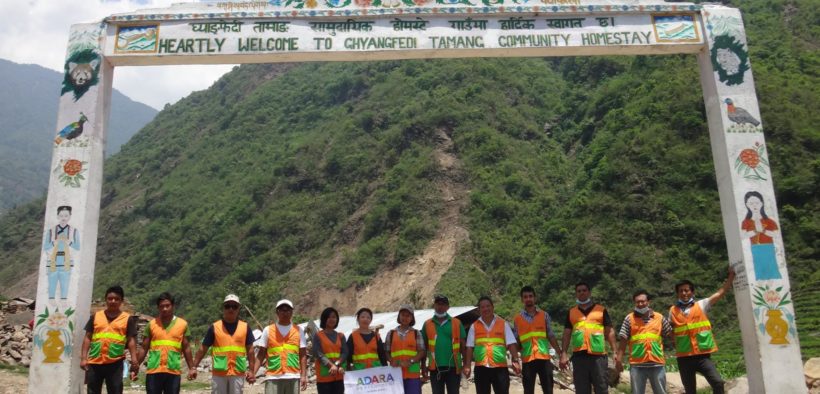What work does Adara do in Nepal?
Adara performs remote community development work in Nepal’s Humla region which is home to over 50,000 people. On any development measure, Humla fares poorly – they have the nation’s lowest literacy rates, maternal and infant mortality well above the Nepali average, and food shortages each winter when families are sometimes snowed in for months. We are tackling these issues through holistic community health and education interventions.
Adara’s second focus is the care, support and reintegration of children at risk. In 2006, we rescued 136 Nepali children from inhumane conditions. Since then, we have been caring for, educating and slowly reintegrating these children with their families. We also partner with some great local Nepali NGOs in Kathmandu and Humla, working with them to improve healthcare, education, and child protection.
Can you talk me through the steps you took as the April 2015 Nepal earthquake hit and relief efforts were actioned?
Almost immediately after the earthquake hit, I was on Skype with Pralhad Dhakal, our brilliant Nepal Country Director, who had already swung into action. Our first priority was to check the safety of our staff and the 136 children that we support. Thankfully no one was hurt, but many homes were destroyed). Within days our team was back at work putting plans in place for the Adara emergency relief response:
- We immediately launched a mobile medical emergency service, and were able to do so quickly because of existing expertise, contacts and supply chain. The camp has now treated over 1,800 people.
- We began working in collaboration with the Nepal government’s Central Children’s Welfare Board (CCWB) to provide psychosocial support and medical treatment to children who have fallen into the child trafficking trade following the earthquake and have been rescued by the government. More than 242 children have been provided with care by Adara.
- The government of Nepal requested international non-government organisations (INGOs) choose a Village Development Committee (VDC) area and focus their response there. Adara’s VDC is Ghangfedi, a village horrifically affected by the earthquake with 100 per cent of buildings destroyed. We are providing nutrition support, shelter, medical care, and education support to Ghangfedi.
What is a CEO’s role when a crisis like a natural disaster hits?
There are three important roles for the CEO in a crisis – coordination, communication and support.
My first responsibility as CEO was to communicate with those on the ground to ensure they were safe and continued to be supported as much as possible. I worked closely with Nepal Country Director Pralhad to:
- Ensure every one of the Adara family was safe and accounted for and there was enough supplies of food, water and power for the Adara children and staff.
- Communicate with the head office staff in Sydney and gather everyone together to work out how best to support our Nepali team on the ground.
- Ensure he got everything he needed and wasn’t inundated from Adarians across the world desperate for news and wanting to re-assure him.
I decided that for the first week, there would be a steady stream of communication through a central person – me. This stopped the airways being clogged up as telecommunication was difficult and meant that Pralhad could concentrate on the work at hand. A Nepal Update was posted on the intranet each day so all staff understood what was happening.
How did you go about setting up an emergency relief appeal?
In the past we have not conducted fundraising campaigns asking for support directly from the public. But with the need so great, and the timing so critical, we made the decision just one day after the earthquake to launch a public fundraising campaign. Our campaign was simple – we sent out an email asking for support and reached out to people on social media. We were blown away by the generous response and raised more than USD$500,000.
What aid has Adara provided?
The Adara team has provided 9,000 sheets of tin to all nine wards and 765 households in Ghangfedi to allow them to build strong temporary shelters against monsoon weather. Locals will be able to reuse the tin for the roof of a more permanent house in the future. We have also distributed educational supplies to the eight schools in Ghangfedi, and families have received a total of 80,000kgs of rice and 1,500 bars of soap. It is very difficult for the people in Ghangfedi to reach Kathmandu for supplies now that the monsoon season has arrived.
What are some tips for other NFP executives responding to a crisis, particularly when it is not in immediate proximity?
Being far away can sometimes make you feel a little powerless, but I think the best thing you can do is trust and support your local teams. They have the ability to respond in real time, and know the cultural, social and political context much better than even the most engaged NFP executive who is far away.
The other thing that I think is really important is ensuring your response is co-ordinated and that you are working with government and INGOs focused on the relief response, including the UN Office for the Coordination of Humanitarian Affairs’ cluster system. Adara joined the health, child protection, nutrition and logistics clusters.
Pralhad has also been in regular contact with the Government of Nepal’s Ministry of Health and District Health Offices, and the Central Children’s Welfare Board. We coordinate with these groups regularly as we develop our plans. This is important to ensure your activities are meeting needs that are the most urgent and pressing, as decided by the central government’s planning process, and that you are not duplicating other NGOs or local authorities’ work.
What is the long-term plan to keep supporting recovery efforts in Nepal?
Now that the emergency phase is over, we need to move into the longer term re-building phase. We have employed a Nepali Earthquake Manager to work closely with Pralhad who has been tirelessly working with the medical team and in child protection, and he will lead the re-building phase.
Nothing much can happen while the monsoons last – till August – as it is very dangerous to move around the country with the risk of landslides increasing. During this time, the senior team will meet to talk about how we can best help Nepal and make the biggest impact over the following year. We will also take a fresh look at school and household structures in our Humla region to ensure we do what we can to ensure they are earthquake resistant.
How can organisations better prepare for a situation like this?
This was really a test of our disaster preparedness, and although I think we responded well, we also have learnt a lot. For instance, although our teams had disaster boxes prepared in the office, they hadn’t been looked at in a while and the food in them was out of date. This disaster has really driven home to us the importance of not becoming complacent with disaster preparedness, as something could happen at any point. We will be de-briefing on what we could do better next time, and re-looking at our disaster plans and protocols.
















































































































































